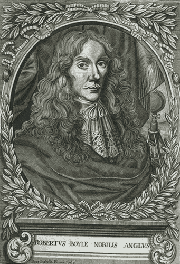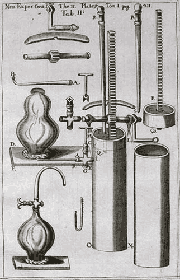|

Robert Boyle
Robert Boyle, Opera Omnia,
Venice 1696

Details and accessories of Boyle's
air-pump.
Robert Boyle, New
Experiments Physico-Mechanicall, Touching the Spring of the Air and
its Effects, Oxford 1660
|
Born in Lismore, in Ireland, he
started his studies at Eton, and at only 12 years old, went, with
his tutor, on a long series of journeys on the European continent.
After a period in Ireland, he settled in 1655 in Oxford, dedicating
himself full-time to scientific research. During these years, he was
in contact with a group of researchers devoted to the study of the
new experimental philosophy. This nucleus of scientists and philosophers,
a few years later, formed the Royal Society, of which Boyle was to
be a founding member
Boyle's reputation is firmly joined to the
definition of the notion of the "chemical element", announced for
the first time in the work The Sceptical Chymist published
in London in 1661. In this work, he proposes a rigorous corpuscular
conception of matter, in drastic opposition to the traditional aristotelian
theory of the four elements (water, air, earth and fire).
In 1657, inspired by reading a description
of pneumatic experiments carried out by Otto von Guericke, Boyle began
to think of building an instrument which might easily produce a vacuum.
Thanks to the partnership of his assistant, Robert Hooke, who was
extremely talented in working out effective solutions to even the
most difficult experimental problems, he succeeded shortly in making
the air-pump, which enabled him to carry out important experiments,
described in the New Experiments physico-mechanicall, Touching
the Spring of the Air and its Effects (1660).
The experiments performed with the air-pump
constructed by Hooke allowed Boyle to show that the suspension of
the column of mercury in the barometric tube, taken from Torricelli's
experiments, were definitely dependent on atmospheric pressure, that
sound was impossible in the vacuum, that air was indispensable to
life and combustion, and, moreover, that air was characterised by
a permanent elasticity, or "spring" as he called it. In studying this
characteristic of air, and through other experiments described in
the second edition of New Experiments (1662), Boyle managed
to determine the relation linking the volume and the pressure of a
gas at a constant temperature (volume changes inversely to pressure),
thus establishing the important principle in physics now called "Boyle's
Law".
|

